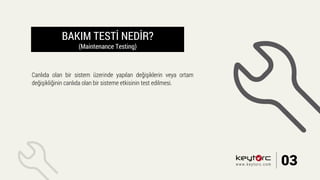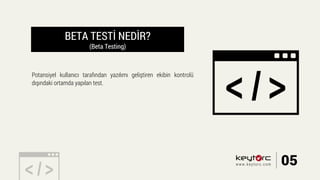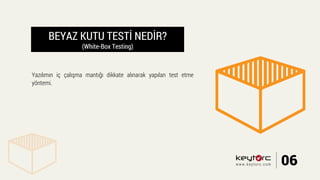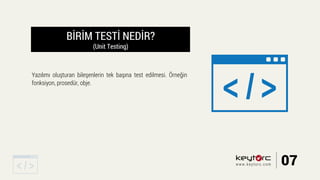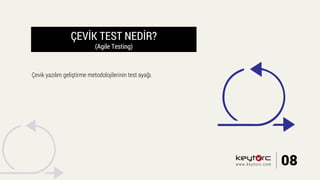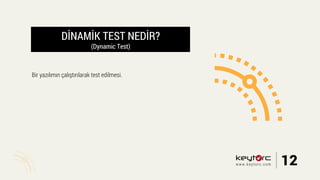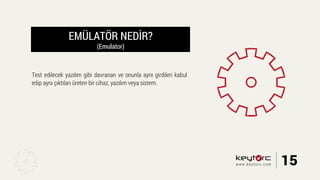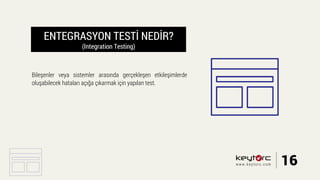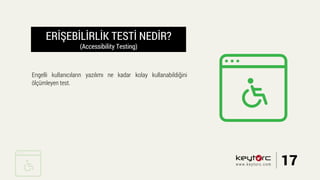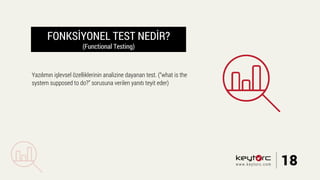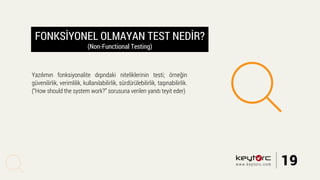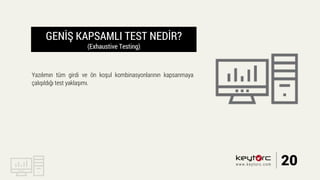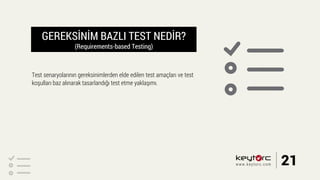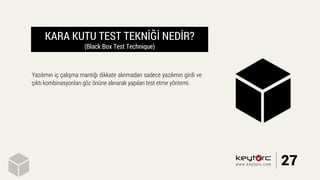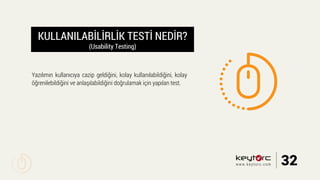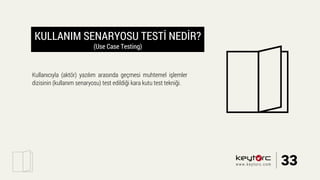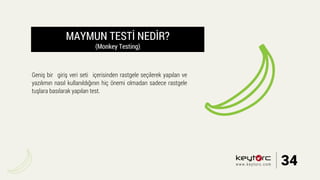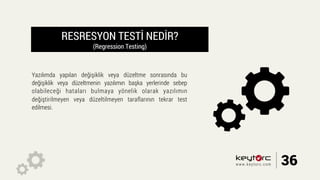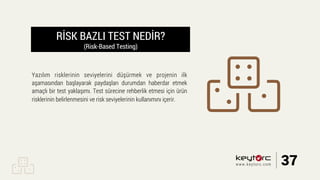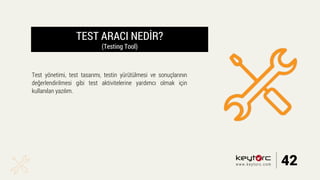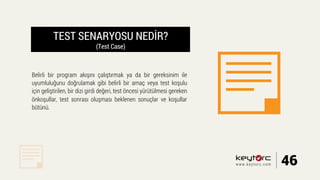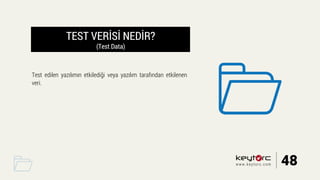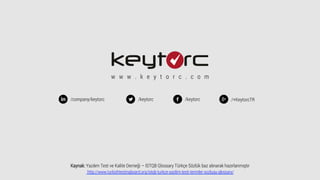50 Soruda YazÄąlÄąm Testi
- 1. 50 Soruda YazÄąlÄąm Testi YazÄąlÄąm Testi hakkÄąnda bilinmesi gereken temel tanÄąmlar, kavramlar
- 2. ALFA TESTÄ° NEDÄ°R? (Alfa Testing) Potansiyel kullanÄącÄą veya baÄÄąmsÄąz test ekibi tarafÄąndan yazÄąlÄąmÄą geliÅtiren ekibin kontrolÞndeki ortamda onlarÄąn yÃķnlendirmesi olmadan yapÄąlan kullanÄącÄą senaryolarÄąnÄą içeren test. 01www.keytorc.com
- 3. AKSÄ°YON KELÄ°MESÄ° GÃDÃMLà TEST NEDÄ°R? (Keyword-Driven Testing) Test girdilerini içeren dosyada sadece test verilerinin ve beklenen sonuçlarÄąn deÄil, aynÄą zamanda test senaryosunu oluÅturacak aksiyon kelimelerinin de bulunduÄu test etme tekniÄi. 02www.keytorc.com
- 4. BAKIM TESTÄ° NEDÄ°R? (Maintenance Testing) CanlÄąda olan bir sistem Þzerinde yapÄąlan deÄiÅiklerin veya ortam deÄiÅikliÄinin canlÄąda olan bir sisteme etkisinin test edilmesi. 03www.keytorc.com
- 5. BAÅARILILIK/BAÅARISIZLIK KRÄ°TERÄ° NEDÄ°R? (Pass/Fail Criteria) Bir test ÃķÄesinin veya ÃķzelliÄin baÅarÄąlÄą veya baÅarÄąsÄąz olup olmadÄąÄÄąnÄą belirlemek için kullanÄąlan karar verme kurallarÄą. 04www.keytorc.com
- 6. BETA TESTÄ° NEDÄ°R? (Beta Testing) Potansiyel kullanÄącÄą tarafÄąndan yazÄąlÄąmÄą geliÅtiren ekibin kontrolÞ dÄąÅÄąndaki ortamda yapÄąlan test. 05www.keytorc.com
- 7. BEYAZ KUTU TESTÄ° NEDÄ°R? (White-Box Testing) YazÄąlÄąmÄąn iç çalÄąÅma mantÄąÄÄą dikkate alÄąnarak yapÄąlan test etme yÃķntemi. 06www.keytorc.com
- 8. BÄ°RÄ°M TESTÄ° NEDÄ°R? (Unit Testing) YazÄąlÄąmÄą oluÅturan bileÅenlerin tek baÅÄąna test edilmesi. ÃrneÄin fonksiyon, prosedÞr, obje. 07www.keytorc.com
- 9. ÃEVÄ°K TEST NEDÄ°R? (Agile Testing) Ãevik yazÄąlÄąm geliÅtirme metodolojilerinin test ayaÄÄą. 08www.keytorc.com
- 10. ÃEVÄ°K YAZILIM GELÄ°ÅTÄ°RME NEDÄ°R? (Agile Software Development) Gereksinimlerin ve çÃķzÞmlerin insiyatif alabilen farklÄą takÄąmlar arasÄą iÅbirliÄi ile ortaya Ã§ÄąkarÄąldÄąÄÄą, gereksinimlerin ve çÃķzÞmlerin zamanla olgunlaÅtÄąÄÄą, bir grup dÃķngÞsel yazÄąlÄąm geliÅtirme metodolojisi. ÃrneÄin Scrum, Kanban, Extreme Programming. 09www.keytorc.com
- 11. ÃIKIÅ KRÄ°TERLERÄ° NEDÄ°R? (Exit Criteria) Bir sÞrecin resmi olarak tamamlanmasÄąna izin vermek için paydaÅlarla kararlaÅtÄąrÄąlmÄąÅ genel ve Ãķzel koÅullar kÞmesi. ÃÄąkÄąÅ kriterinin amacÄą, iÅin hala bitirilmemiÅ kÄąsÄąmlarÄą varken o iÅin tamamlanmÄąÅ olarak deÄerlendirilmesini Ãķnlemektir. ÃÄąkÄąÅ kriterleri testin ne zaman sonlanacaÄÄąnÄą planlamak ve raporlama için kullanÄąlÄąr. 10www.keytorc.com
- 12. DENKLÄ°K PAYI NEDÄ°R? (Equivalence Partitioning) Gereksinimler baz alÄąnarak bir yazÄąlÄąmÄąn aynÄą davranÄąÅlarÄą sergilediÄi girdi veya Ã§ÄąktÄą alanÄąnÄąn bir kÄąsmÄą. 11www.keytorc.com
- 13. DÄ°NAMÄ°K TEST NEDÄ°R? (Dynamic Test) Bir yazÄąlÄąmÄąn çalÄąÅtÄąrÄąlarak test edilmesi. 12www.keytorc.com
- 14. DOÄRULAMA NEDÄ°R? (VeriïŽcation) YazÄąlÄąmÄąn doÄru bir Åekilde geliÅtirilip geliÅtirilmediÄinin teyitlenmesi. ÃrneÄin yazÄąlÄąmÄąn iyi bir tasarÄąma sahip olup olmamasÄą. (Doing the thing right â Ä°Åin doÄru yapÄąlmasÄą) 13www.keytorc.com
- 15. DUMAN TESTÄ° NEDÄ°R? (Smoke Test) Bir yazÄąlÄąmÄąn en Ãķnemli fonksiyonlarÄąnÄąn çalÄąÅÄąp çalÄąÅmadÄąÄÄąnÄą anlamak amacÄąyla detaylara girmeden yapÄąlan test tekniÄi. 14www.keytorc.com
- 16. EMÃLATÃR NEDÄ°R? (Emulator) Test edilecek yazÄąlÄąm gibi davranan ve onunla aynÄą girdileri kabul edip aynÄą Ã§ÄąktÄąlarÄą Þreten bir cihaz, yazÄąlÄąm veya sistem. 15www.keytorc.com
- 17. ENTEGRASYON TESTÄ° NEDÄ°R? (Integration Testing) BileÅenler veya sistemler arasÄąnda gerçekleÅen etkileÅimlerde oluÅabilecek hatalarÄą aÃ§ÄąÄa Ã§Äąkarmak için yapÄąlan test. 16www.keytorc.com
- 18. ERÄ°ÅEBÄ°LÄ°RLÄ°K TESTÄ° NEDÄ°R? (Accessibility Testing) Engelli kullanÄącÄąlarÄąn yazÄąlÄąmÄą ne kadar kolay kullanabildiÄini ÃķlçÞmleyen test. 17www.keytorc.com
- 19. FONKSÄ°YONEL TEST NEDÄ°R? (Functional Testing) YazÄąlÄąmÄąn iÅlevsel Ãķzelliklerinin analizine dayanan test. (âwhat is the system supposed to do?â sorusuna verilen yanÄątÄą teyit eder) 18www.keytorc.com
- 20. FONKSÄ°YONEL OLMAYAN TEST NEDÄ°R? (Non-Functional Testing) YazÄąlÄąmÄąn fonksiyonalite dÄąÅÄąndaki niteliklerinin testi; ÃķrneÄin gÞvenilirlik, verimlilik, kullanÄąlabilirlik, sÞrdÞrÞlebilirlik, taÅÄąnabilirlik. (âHow should the system work?â sorusuna verilen yanÄątÄą teyit eder) 19www.keytorc.com
- 21. GENÄ°Å KAPSAMLI TEST NEDÄ°R? (Exhaustive Testing) YazÄąlÄąmÄąn tÞm girdi ve Ãķn koÅul kombinasyonlarÄąnÄąn kapsanmaya çalÄąÅÄąldÄąÄÄą test yaklaÅÄąmÄą. 20www.keytorc.com
- 22. GEREKSÄ°NÄ°M BAZLI TEST NEDÄ°R? (Requirements-based Testing) Test senaryolarÄąnÄąn gereksinimlerden elde edilen test amaçlarÄą ve test koÅullarÄą baz alÄąnarak tasarlandÄąÄÄą test etme yaklaÅÄąmÄą. 21www.keytorc.com
- 23. GÄ°RÄ°Å KRÄ°TERLERÄ° NEDÄ°R? (Entry Criteria) Bir sÞrecin baÅlamasÄąna veya ilerlemesine izin vermek için kullanÄąlan genel ve Ãķzel koÅullar kÞmesi. GiriÅ kriterlerinin amacÄą baÅarÄąsÄąz olma ihtimali yÞksek bir iÅleme baÅlanmasÄąnÄą Ãķnleyerek verimliliÄi artÄąrmaktÄąr. 22www.keytorc.com
- 24. HATA YOÄUNLUÄU NEDÄ°R? (Defect Density) Bir yazÄąlÄąmda bulunan hata sayÄąsÄąnÄąn yazÄąlÄąmÄąn bÞyÞklÞÄÞne oranÄą (Ãķrn. kod satÄąr sayÄąsÄą, sÄąnÄąf sayÄąsÄą, fonksiyon puanlarÄą) 23www.keytorc.com
- 25. HATA TESPÄ°T YÃZDESÄ° NEDÄ°R? (Defect Detection Percentage â DDP) Bir test fazÄąnda bulunan hatalarÄąn sayÄąsÄąnÄąn, aynÄą fazda ve daha sonraki fazlarda bulunan hatalarÄąn sayÄąsÄąna oranÄą. 24www.keytorc.com
- 26. Ä°KÄ°LÄ° TEST NEDÄ°R? (Pairwise Testing) YazÄąlÄąmÄąn tÞm ikili girdi kombinasyonlarÄąnÄą çalÄąÅtÄąrmak için test senaryolarÄąnÄąn tasarlandÄąÄÄą kara kutu test tasarÄąm tekniÄi. 25www.keytorc.com
- 27. Ä°ZLENEBÄ°LÄ°RLÄ°K NEDÄ°R? (Traceability) Gereksinimlerin test senaryolarÄąyla iliÅkilendirilmesi gibi, yazÄąlÄąm ve dokÞmantasyonun içinde birbiriyle ilgili ÃķÄelerin iliÅkilendirilmesi. 26www.keytorc.com
- 28. KARA KUTU TEST TEKNÄ°ÄÄ° NEDÄ°R? (Black Box Test Technique) YazÄąlÄąmÄąn iç çalÄąÅma mantÄąÄÄą dikkate alÄąnmadan sadece yazÄąlÄąmÄąn girdi ve Ã§ÄąktÄą kombinasyonlarÄą gÃķz ÃķnÞne alÄąnarak yapÄąlan test etme yÃķntemi. 27www.keytorc.com
- 29. KARAR TABLOSU TESTÄ° NEDÄ°R? (Decision Table Testing) Test senaryolarÄąnÄąn bir karar tablosundaki girdi ve/veya neden kombinasyonlarÄą ile bunlara baÄlÄą Ã§ÄąktÄą ve/veya sonuçlarÄą içerecek Åekilde tasarlandÄąÄÄą kara kutu test tekniÄi. 28www.keytorc.com
- 30. KEÅÄ°F TESTÄ° NEDÄ°R? (Exploratory Testing) Test edenin daha iyi ve daha yeni testleri tasarlamak için test yaparken edindiÄi bilgiyi kullanarak ve bu testleri yÞrÞterek bilïŽil test tasarÄąmÄąnÄą kontrol altÄąna aldÄąÄÄą gayri resmi test tasarÄąm tekniÄi. 29www.keytorc.com
- 31. KULLANICI HÄ°KAYESÄ° TESTÄ° NEDÄ°R? (User Story Testing) KullanÄącÄą bakÄąÅ aÃ§ÄąsÄąyla oluÅturulmuÅ cÞmlelerden oluÅan kullanÄącÄą hikayelerini baz alarak tasarlanan kara kutu test tasarÄąm tekniÄi. 30www.keytorc.com
- 32. KULLANICI KABUL TESTÄ° NEDÄ°R? (User Acceptance Testing) YazÄąlÄąmÄąn kabul edilmesine karar vermek için yapÄąlan; kullanÄącÄą ihtiyaçlarÄą, gereksinimleri ve iÅ sÞrecine gÃķre yÞrÞtÞlen, yazÄąlÄąmÄąn kabul kriterine uygunluÄunu, kullanÄącÄąyÄą, mÞÅteriyi veya yetkili birimi etkin kÄąlarak denetleyen resmi test aktivitesi. 31www.keytorc.com
- 33. KULLANILABÄ°LÄ°RLÄ°K TESTÄ° NEDÄ°R? (Usability Testing) YazÄąlÄąmÄąn kullanÄącÄąya cazip geldiÄini, kolay kullanÄąlabildiÄini, kolay ÃķÄrenilebildiÄini ve anlaÅÄąlabildiÄini doÄrulamak için yapÄąlan test. 32www.keytorc.com
- 34. KULLANIM SENARYOSU TESTÄ° NEDÄ°R? (Use Case Testing) KullanÄącÄąyla (aktÃķr) yazÄąlÄąm arasÄąnda geçmesi muhtemel iÅlemler dizisinin (kullanÄąm senaryosu) test edildiÄi kara kutu test tekniÄi. 33www.keytorc.com
- 35. MAYMUN TESTÄ° NEDÄ°R? (Monkey Testing) GeniÅ bir giriÅ veri seti içerisinden rastgele seçilerek yapÄąlan ve yazÄąlÄąmÄąn nasÄąl kullanÄąldÄąÄÄąnÄąn hiç Ãķnemi olmadan sadece rastgele tuÅlara basÄąlarak yapÄąlan test. 34www.keytorc.com
- 36. PERFORMANS TESTÄ° NEDÄ°R? (Performance Testing) Bir yazÄąlÄąmÄąn performansÄąnÄą belirlemek için yÞrÞtÞlen fonksiyonel olmayan test çeÅidi. (ÃrneÄin iÅlem sÞresi, cevap sÞresi, verim oranÄą vb.) 35www.keytorc.com
- 37. RESRESYON TESTÄ° NEDÄ°R? (Regression Testing) YazÄąlÄąmda yapÄąlan deÄiÅiklik veya dÞzeltme sonrasÄąnda bu deÄiÅiklik veya dÞzeltmenin yazÄąlÄąmÄąn baÅka yerlerinde sebep olabileceÄi hatalarÄą bulmaya yÃķnelik olarak yazÄąlÄąmÄąn deÄiÅtirilmeyen veya dÞzeltilmeyen taraflarÄąnÄąn tekrar test edilmesi. 36www.keytorc.com
- 38. RÄ°SK BAZLI TEST NEDÄ°R? (Risk-Based Testing) YazÄąlÄąm risklerinin seviyelerini dÞÅÞrmek ve projenin ilk aÅamasÄąndan baÅlayarak paydaÅlarÄą durumdan haberdar etmek amaçlÄą bir test yaklaÅÄąmÄą. Test sÞrecine rehberlik etmesi için ÞrÞn risklerinin belirlenmesini ve risk seviyelerinin kullanÄąmÄąnÄą içerir. 37www.keytorc.com
- 39. SAÄLAMA NEDÄ°R? (Validation) KullanÄącÄą gereksinimlerini karÅÄąlayan doÄru yazÄąlÄąmÄąn geliÅtirilip geliÅtirilmediÄinin teyitlenmesi. (Doing the right thing â DoÄru iÅin yapÄąlmasÄą) 38www.keytorc.com
- 40. SINIR DEÄER ANALÄ°ZÄ° NEDÄ°R? (Boundary Value Analysis) Test senaryolarÄąnÄąn, sÄąnÄąr deÄerlerine gÃķre tasarlandÄąÄÄą kara kutu test tasarÄąm tekniÄi. ÃrneÄin bir sayÄą aralÄąÄÄąnÄąn minimum veya maximum deÄeri. 39www.keytorc.com
- 41. STRES TESTÄ° NEDÄ°R? (Stress Testing) Bir yazÄąlÄąmÄąn ÃķngÃķrÞlen veya belirlenmiŠçalÄąÅma yÞkÞnÞn sÄąnÄąrlarÄąnda ya da Ãķtesinde, ya da bellek veya sunucuya eriÅimi gibi kaynaklarÄąn azalmasÄą durumundaki çalÄąÅma kapasitesini deÄerlendirmek için yÞrÞtÞlen bir çeÅit performans testi. 40www.keytorc.com
- 42. TAÅINABÄ°LÄ°RLÄ°K TESTÄ° NEDÄ°R? (Portability Testing) YazÄąlÄąmÄąn bir ortamdan baÅka bir ortama ne kadar kolay taÅÄąnabildiÄinin test edilmesi. 41www.keytorc.com
- 43. TEST ARACI NEDÄ°R? (Testing Tool) Test yÃķnetimi, test tasarÄąmÄą, testin yÞrÞtÞlmesi ve sonuçlarÄąnÄąn deÄerlendirilmesi gibi test aktivitelerine yardÄąmcÄą olmak için kullanÄąlan yazÄąlÄąm. 42www.keytorc.com
- 44. TEST KOÅULU NEDÄ°R? (Test Condition) Bir ya da daha çok test senaryosu ile doÄrulanabilen yazÄąlÄąmÄąn bir ÃķÄesi ya da olayÄą. ÃrneÄin bir fonksiyon, iÅlem, Ãķzellik, kalite niteliÄi veya yapÄąsal ÃķÄe. 43www.keytorc.com
- 45. TEST ESASI NEDÄ°R? (Test Basis) Bir yazÄąlÄąmÄąn gereksinimlerinin Ã§ÄąkarÄąlabileceÄi tÞm belgeler. Test senaryolarÄąnÄąn dayandÄąrÄąldÄąÄÄą dokÞmantasyon. 44www.keytorc.com
- 46. TEST KÃMESÄ° NEDÄ°R? (Test Set â Test Suite) YazÄąlÄąmÄą test etmek için oluÅturulmuÅ test senaryolarÄą kÞmesi. 45www.keytorc.com
- 47. TEST SENARYOSU NEDÄ°R? (Test Case) Belirli bir program akÄąÅÄąnÄą çalÄąÅtÄąrmak ya da bir gereksinim ile uyumluluÄunu doÄrulamak gibi belirli bir amaç veya test koÅulu için geliÅtirilen, bir dizi girdi deÄeri, test Ãķncesi yÞrÞtÞlmesi gereken ÃķnkoÅullar, test sonrasÄą oluÅmasÄą beklenen sonuçlar ve koÅullar bÞtÞnÞ. 46www.keytorc.com
- 48. TEST STRATEJÄ°SÄ° NEDÄ°R? (Test Strategy) KoÅturulacak test seviyelerinin ve bu seviyelerdeki test sÞreçlerinin Þst seviye tanÄąmÄą. 47www.keytorc.com
- 49. TEST VERÄ°SÄ° NEDÄ°R? (Test Data) Test edilen yazÄąlÄąmÄąn etkilediÄi veya yazÄąlÄąm tarafÄąndan etkilenen veri. 48www.keytorc.com
- 50. VERÄ° GÃDÃMLà TEST NEDÄ°R? (Data-Driven Testing) Test girdi ve beklenen sonuçlarÄąnÄą bir tabloda saklayan, bu sayede tek bir test betiÄinin tablodaki tÞm testleri çalÄąÅtÄąrabildiÄi bir test tekniÄi. 49www.keytorc.com
- 51. YÃK TESTÄ° NEDÄ°R? (Load Testing) Bir çeÅit performans testi. Bir yazÄąlÄąmÄąn artan yÞk (Ãķr. eÅzamanlÄą kullanÄącÄąlarÄąn sayÄąsÄą ve/veya iÅlem sayÄąsÄą) karÅÄąsÄąndaki davranÄąÅlarÄąnÄą deÄerlendirmek için kullanÄąlÄąr. YazÄąlÄąmÄąn yÞkÞ ne kadar kaldÄąrabileceÄi tespit edilir. 50www.keytorc.com
- 52. w w w . k e y t o r c . c o m /company/keytorc /keytorc/keytorc /+KeytorcTR Kaynak: YazÄąlÄąm Test ve Kalite DerneÄi â ISTQB Glossary TÞrkçe SÃķzlÞk baz alÄąnarak hazÄąrlanmÄąÅtÄąr http://www.turkishtestingboard.org/istqb-turkce-yazilim-testi-terimler-sozlugu-glossary/




